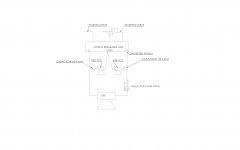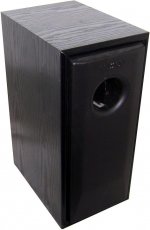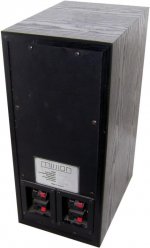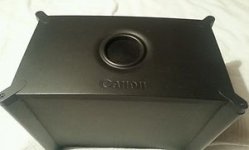I am in the process of building a small passive sub for a PC system. It will be powered by a DTA-1 T-Amp. I can design the box, I can build it, etc. But, when it comes to electronics I need some guidance.
I want to go from the L/R speaker output on the amp, to the sub, then the signal continues from the sub to the speakers. I know I need a High Pass filter, so only signals under 120 Hz go to the sub. The speakers is no problem, because they are full range (2-1/2" Dayton Audio ND-65-8 FR drivers).
How do I do the internal wiring for the sub? For connection I will be using spring terminals. Have not calculated the HPF, but there are plenty of calcs for that. Basically, how do I wire from the spring input terminal to the HPF, then to the sub driver, and how do I go from there, or from the input terminal, to the output spring terminal, while keeping everything 8 Ohms?
I want to go from the L/R speaker output on the amp, to the sub, then the signal continues from the sub to the speakers. I know I need a High Pass filter, so only signals under 120 Hz go to the sub. The speakers is no problem, because they are full range (2-1/2" Dayton Audio ND-65-8 FR drivers).
How do I do the internal wiring for the sub? For connection I will be using spring terminals. Have not calculated the HPF, but there are plenty of calcs for that. Basically, how do I wire from the spring input terminal to the HPF, then to the sub driver, and how do I go from there, or from the input terminal, to the output spring terminal, while keeping everything 8 Ohms?
in the process of building a small passive sub for a PC system
It is a 8 Ohm, just having the subs in parallel doesn't change a thing, they work in different frequencies. Small changes in overall impedance if working with the right design.how do I go from there, or from the input terminal, to the output spring terminal, while keeping everything 8 Ohms?
Many times the "old" type subs you mention where 4th Order Bandpass Systems with two subs drivers.
It is a 8 Ohm, just having the subs in parallel doesn't change a thing, they work in different frequencies. Small changes in overall impedance if working with the right design.
Many times the "old" type subs you mention where 4th Order Bandpass Systems with two subs drivers.
I think you got it wrong. All I want is to power the sub (one 8 Ohm) woofer using the 2-Channels from the amp, then going on to power the speakers. Obviously, I need to filter the signal to the woofer, so it only carries 120 Hz and below.
You can't use both sides of the amp to power one single voice coil sub.I think you got it wrong. All I want is to power the sub (one 8 Ohm) woofer using the 2-Channels from the amp, then going on to power the speakers. Obviously, I need to filter the signal to the woofer, so it only carries 120 Hz and below.
Fortunately, most bass is mixed mono, so operating the sub from only one side of the amp is not a problem.
If your sub had dual voice coils, you could use both sides of the amp.
You also need to filter the lows out of the 2.5" high speakers or they will distort.
At minimum you will need an inductor in series with the sub, and a capacitor in series with each of the high speakers.
There is a sticky on making passive crossovers on the multi way forum.
No I didn't. You have to learn on how to operate the 4th Order Bandpass Speaker system from the point of view of the natural/acoustic filter roll off. 😀I think you got it wrong.
Using dual woofers (or dvc) and matching then the satellites it's easy... (this is if that's what you're looking for).
You can't use both sides of the amp to power one single voice coil sub.
Fortunately, most bass is mixed mono, so operating the sub from only one side of the amp is not a problem.
If your sub had dual voice coils, you could use both sides of the amp.
You also need to filter the lows out of the 2.5" high speakers or they will distort.
At minimum you will need an inductor in series with the sub, and a capacitor in series with each of the high speakers.
There is a sticky on making passive crossovers on the multi way forum.
I can do the crossover, that is no problem. It is just that I'm being told that I cannot do it using a single amp, that I need a 2.1 amp, or an amp for the sub, and an amp for the speakers. I'm aware about DVC. My intention was to take advantage of the mono low signal of one channel to power the sub, then continue to the speaker.
No I didn't. You have to learn on how to operate the 4th Order Bandpass Speaker system from the point of view of the natural/acoustic filter roll off. 😀
Using dual woofers (or dvc) and matching then the satellites it's easy... (this is if that's what you're looking for).
Understood...Looking for the later. Thanks, using the speakers as satellites of the sub is the correct term.
By the way, speaking as someone who had to design them, passive sub crossovers DON'T WORK.
Not really.
The impedance peaks at the resonances of the sub and satellites interfere to much for any simple passive design to function as designed. Yeah, you can kind cut out some low bass from the satellites and some highs out of the sub, but it will be a very crude approximation.
Not really.
The impedance peaks at the resonances of the sub and satellites interfere to much for any simple passive design to function as designed. Yeah, you can kind cut out some low bass from the satellites and some highs out of the sub, but it will be a very crude approximation.
By the way, speaking as someone who had to design them, passive sub crossovers DON'T WORK.
Not really.
The impedance peaks at the resonances of the sub and satellites interfere to much for any simple passive design to function as designed. Yeah, you can kind cut out some low bass from the satellites and some highs out of the sub, but it will be a very crude approximation.
Thanks for the advise, any recommendations on an active XO that will not break the bank.
By the way, speaking as someone who had to design them, passive sub crossovers DON'T WORK.
Not really.
The impedance peaks at the resonances of the sub and satellites interfere to much for any simple passive design to function as designed. Yeah, you can kind cut out some low bass from the satellites and some highs out of the sub, but it will be a very crude approximation.
Yes agreed that a passive system won't work very well but there are ways to get a system functioning with 3 speakers.
In car audio amplifiers, often one channel has the signal inverted and the outputs labelled according to the phase. This allows for easy bridging of the amplifier outputs. The speaker connection is just moved from one connection to the other one to bridge the amplifier.
So it stands to reason that if the stereo amp has one input signal inverted by use of a opamp (or transformer!) then the amplifier can be bridged in the same manner.
It is then possble to run a pair of stereo speakers in normal mode but with one speaker connected in reverse to re-correct the phase, and a single speaker in bridged mode.
There are issues with the overal impedance loads that the amp must tolerate, and the sub especially must be not to low an impedance, but it does work (crudely)😱
Attachments
Examples:...the 4th Order Bandpass Speaker system
Mission 73PI Passive Sub
Canon S-B20 Passive Sub
JBL Control SB-2 Passive Sub (Dual Coil)
Attachments
I agree and disagree, doesn't mean it can't be done... 😀By the way, speaking as someone who had to design them, passive sub crossovers DON'T WORK.
Not really.
The impedance peaks at the resonances of the sub and satellites interfere to much for any simple passive design to function as designed. Yeah, you can kind cut out some low bass from the satellites and some highs out of the sub, but it will be a very crude approximation.
Mission 73pi - passive sub | AVForums.com - UK Online
Last edited:
Yeah, that's one of the applications I had to design passive crossovers for, which can't really work properly. Of course, you will hear sound, but that does not mean it is accurate. In that kind of configuration, you might accidentally load the amplifier down really hard at certain frequencies.Yes agreed that a passive system won't work very well but there are ways to get a system functioning with 3 speakers.
In car audio amplifiers, often one channel has the signal inverted and the outputs labelled according to the phase. This allows for easy bridging of the amplifier outputs. The speaker connection is just moved from one connection to the other one to bridge the amplifier.
So it stands to reason that if the stereo amp has one input signal inverted by use of a opamp (or transformer!) then the amplifier can be bridged in the same manner.
It is then possble to run a pair of stereo speakers in normal mode but with one speaker connected in reverse to re-correct the phase, and a single speaker in bridged mode.
There are issues with the overal impedance loads that the amp must tolerate, and the sub especially must be not to low an impedance, but it does work (crudely)😱
Thanks for the advise, any recommendations on an active XO that will not break the bank.
The cheapest active would actually be passive filters feeding the power amplifiers. For example, a capacitor in-line with the satellite amp, and an inductor in-line with the sub amp.
If you don't want to make homemade, Google "Harrison FMOD" or look at Amazon or Parts Express.
The cheapest active would actually be passive filters feeding the power amplifiers. For example, a capacitor in-line with the satellite amp, and an inductor in-line with the sub amp.
If you don't want to make homemade, Google "Harrison FMOD" or look at Amazon or Parts Express.
Thanks for your advice. I don't mind going the DIY route, just a learning curve as far as designing XO goes, but as far as soldering, brand/model selection, etc. I got it pretty much under control. Will check H-FMOD anyways.
But, I already went the "easy route", and maybe what would have been the most logical. Took the good 'ol 1998 8" 50W Audio Source SA-50 that I had in the family room (very good with music and movies, but lacked the extra "oomph" to rattle windows and feel explosions in your bones), and moved to my home office, as it was compact enough to fit under a PC workstation. It's plate amp already has the "by-pass" needed for satellite speakers. Then I ordered a Bravox PXW12D-2, and Dayton SPA-250 Plate Amp to build a sub for the family room. With a 200L enclosure it will produce an Fb of 22 Hz, and an F3 of 20 Hz, and an all concrete home like mine can make it go even lower.
Last edited:
You got two Basic Active Subs then... 😀
Yep, the passive was becoming to much of a hassle for what I wanted to do...😱
- Status
- Not open for further replies.
- Home
- Loudspeakers
- Subwoofers
- Basic Passive Sub Question (Wiring)




